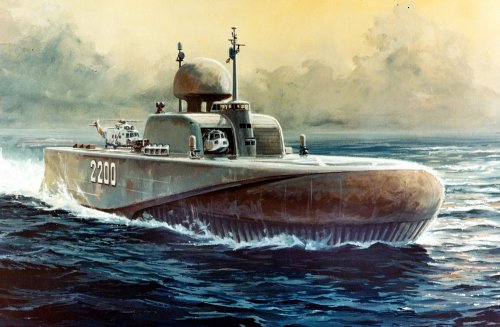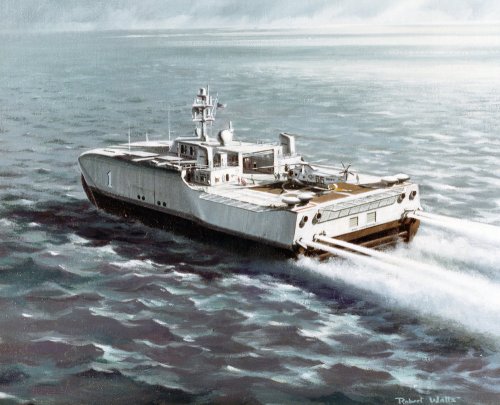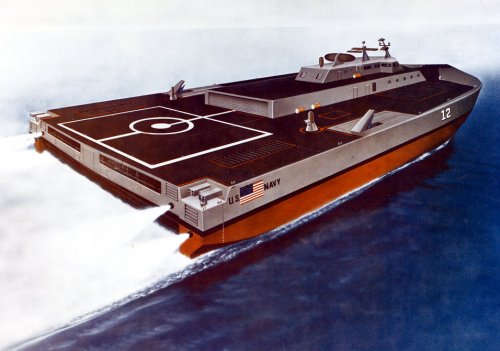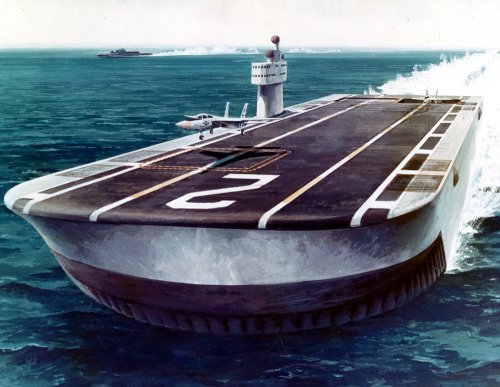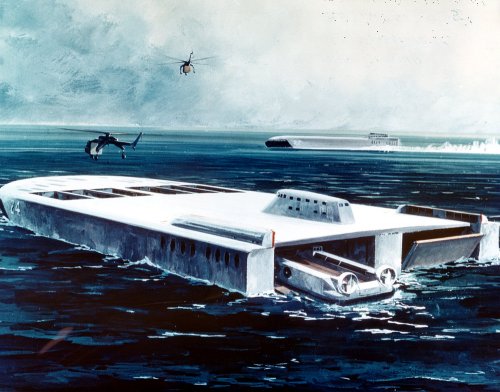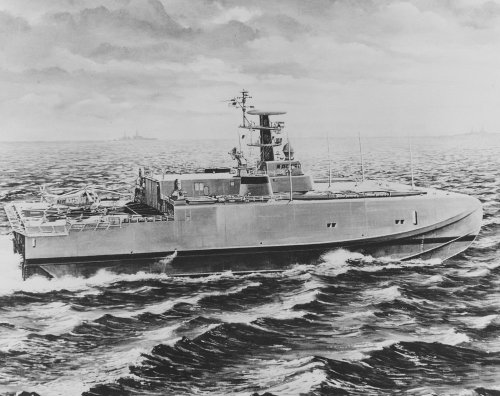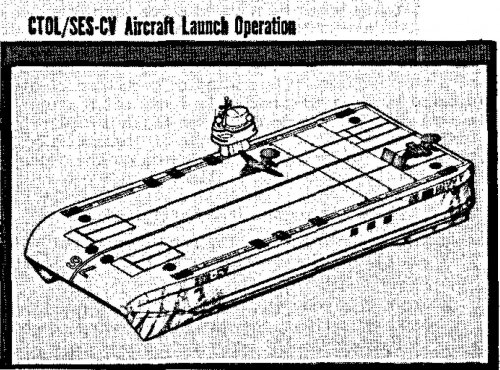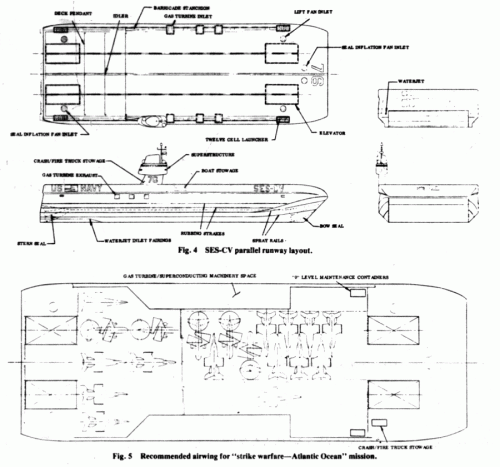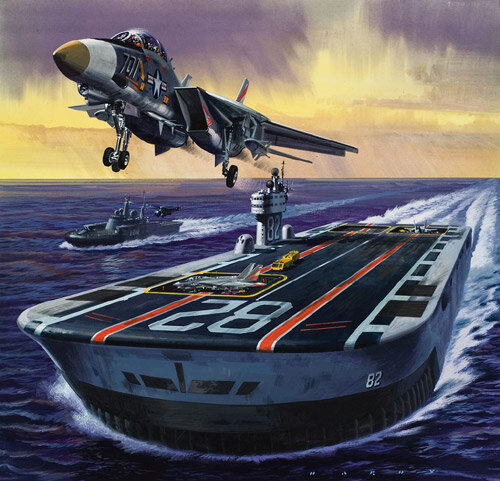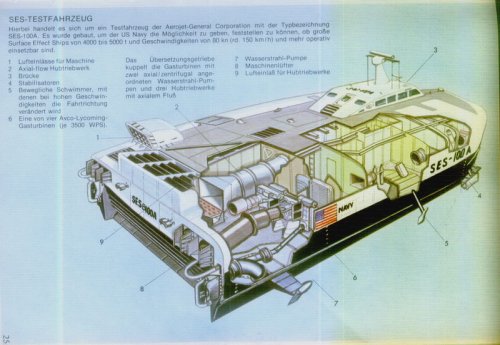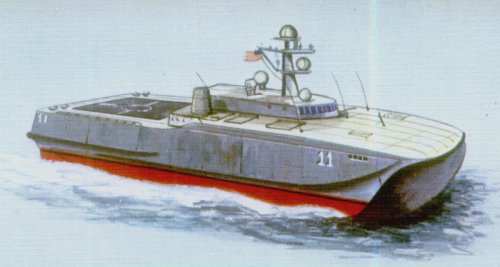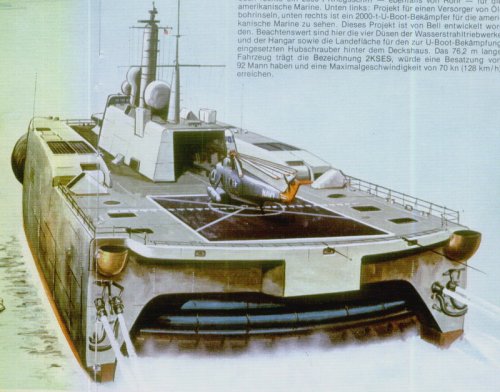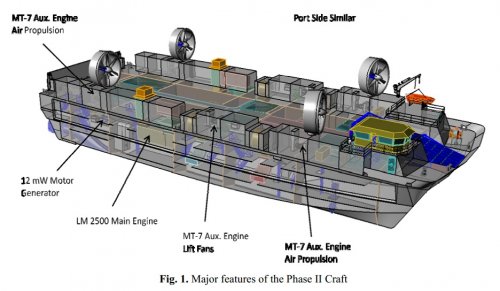The NHHC Photo Section was thick with these things.
You are using an out of date browser. It may not display this or other websites correctly.
You should upgrade or use an alternative browser.
You should upgrade or use an alternative browser.
US Navy Surface Effect Ship (SES) Concepts
- Thread starter RyanC
- Start date
No, I cleaned out the "Artists concepts, surface" folder -- though they did have photographs of the actual prototype SES that the navy operated -- I didn't scan those -- since I was more interested in things that shoot, or carry tanks that shoot.
- Joined
- 31 May 2006
- Messages
- 657
- Reaction score
- 440
Back in the 70's when dinosaurs roamed the earth and I was a mere stripling lad there was a wonderful magazine called 'Speed and Power' which did an article on hovercraft warships, which IIRC was titled 'The 100 Knot Navy'. It had a great painting of an F14 taking off from a hovercraft aircrat carrier and noted that catapults and arresting gear would not be needed on such a ship.
- Joined
- 29 September 2006
- Messages
- 1,793
- Reaction score
- 1,360
Nick Sumner said:Back in the 70's when dinosaurs roamed the earth and I was a mere stripling lad there was a wonderful magazine called 'Speed and Power' which did an article on hovercraft warships, which IIRC was titled 'The 100 Knot Navy'. It had a great painting of an F14 taking off from a hovercraft aircrat carrier and noted that catapults and arresting gear would not be needed on such a ship.
A painting by the amazing Wilf Hardy, the original available from here:http://www.bookpalace.com/cgi-bin/sh000001.pl?REFPAGE=http%3a%2f%2fwww.bookpalace.com%2facatalog%2f&WD=hardy&PN=Home_Wilf_Hardy.html%23aHardyHoverCarrierLL#aHardyHoverCarrierLL

- Joined
- 12 July 2008
- Messages
- 394
- Reaction score
- 148
Attempt to maintain something as complicated as an F-14 while being vibrated like crazy at 100 knots would have been fun.
Through sheer happenstance, last night I spent some time trying to organize some of my many, many photocopies. One I came across and set aside was a bad copy of an article in Jounral of Aircraft about a Lockheed design for a SES aircraft carrier, including three-view drawing. Looked just like the painting above...
It also appears in a paper on SES design I have. I wondered who it originated with!
- RP1
- RP1
A
AAAdrone
Guest
@Sea Skimmer
Look on the bright side, at least higher take off speeds for the F-14s can be achieved! ;D
Look on the bright side, at least higher take off speeds for the F-14s can be achieved! ;D
Gas turbine inlets? Considering the needs of carriers, that would be a serious drain against range/performance wouldn't it? You would probably be restricted to hover "boosts" for aircraft launch/recovery ops, but displacement mode for regular ops and transit.
Unless someone was serious about a nuclear powered SES carrier...
Which would be a very strange confluence of circumstances. The indirect cycle airborne reactor work would actually be potentially more applicable here, using a high temperature molten coolant nuclear reactor for high performance, as it essentially is a nuclear heated gas turbine that sucks in outside air, and outputs hot exhaust and shaft power for additional air compressors and generators (feeding power to conventional electric propellers?). This bypasses the need for a brutally large steam powerplant setup and provides air for the SES air bubble. You would lose some performance using a closed cycle nitrogen gas turbine with exhaust cooled by seawater (or an intermediary pure water circuit) heat exchanger exclusively, but then would be focusing on shaft power for a separate air compressor and generator exclusively and keep people with nuclear adversion from having a stroke.
Unless someone was serious about a nuclear powered SES carrier...
Which would be a very strange confluence of circumstances. The indirect cycle airborne reactor work would actually be potentially more applicable here, using a high temperature molten coolant nuclear reactor for high performance, as it essentially is a nuclear heated gas turbine that sucks in outside air, and outputs hot exhaust and shaft power for additional air compressors and generators (feeding power to conventional electric propellers?). This bypasses the need for a brutally large steam powerplant setup and provides air for the SES air bubble. You would lose some performance using a closed cycle nitrogen gas turbine with exhaust cooled by seawater (or an intermediary pure water circuit) heat exchanger exclusively, but then would be focusing on shaft power for a separate air compressor and generator exclusively and keep people with nuclear adversion from having a stroke.
- Joined
- 31 May 2006
- Messages
- 657
- Reaction score
- 440
Thank you Starviking! Blimey that brings back some memories!
- Joined
- 29 September 2006
- Messages
- 1,793
- Reaction score
- 1,360
Nick Sumner said:Thank you Starviking! Blimey that brings back some memories!
Happy to help ;D
nuclear powered SES carrier
Paper I got mentions a nuclear SES study. The core was NERVA derived and a closed cycle Helium turbine was to be used. Total module could replace LM2500 WRT dimensions.
Miller, RT (CAPTN USN Rtd), "Maritime Applications of an Advanced Gas-Cooled Reactor Propulsion System", SNAME 1977
- RP1
- Joined
- 12 July 2008
- Messages
- 394
- Reaction score
- 148
This the paper?
http://www.atomicengines.com/Documents/WestinghousMaritime.pdf
If you went nuclear power, you could also go even further and copy the USN studied idea of having on-board nuclear powered ammonia production to fuel the aircraft. 100 knots would also make some crazy levels of COD flights possible, allowing the ship to operate with minimal external support which is good since 100knot supply ships are unlikely; though I suppose one of those 40 knot catamaran ferries would be realistic enough at that point.
http://www.atomicengines.com/Documents/WestinghousMaritime.pdf
If you went nuclear power, you could also go even further and copy the USN studied idea of having on-board nuclear powered ammonia production to fuel the aircraft. 100 knots would also make some crazy levels of COD flights possible, allowing the ship to operate with minimal external support which is good since 100knot supply ships are unlikely; though I suppose one of those 40 knot catamaran ferries would be realistic enough at that point.
Attachments
Last edited by a moderator:
That's the one.
Going seriously OT:
Not enough displacement. A large trimaran would be possible, although really there's not going to be much advantage over a monohull at that size unless you're going over 40 knots.
It all depends on how you plan to use the SES' speed, I suppose. No point in changing the enemy objective from the well defended carrier to the poorly defended AOE. This is always the problem with increasing fleet speeds.
BTW for reference I once did a mothership design that would probably make a reasonable 40 knot monohull AOE. Needed 250MWshaft.
- RP1
Going seriously OT:
though I suppose one of those 40 knot catamaran ferries would be realistic enough at that point.
Not enough displacement. A large trimaran would be possible, although really there's not going to be much advantage over a monohull at that size unless you're going over 40 knots.
It all depends on how you plan to use the SES' speed, I suppose. No point in changing the enemy objective from the well defended carrier to the poorly defended AOE. This is always the problem with increasing fleet speeds.
BTW for reference I once did a mothership design that would probably make a reasonable 40 knot monohull AOE. Needed 250MWshaft.
- RP1
- Joined
- 12 July 2008
- Messages
- 394
- Reaction score
- 148
You really don't need that much displacement though if all you are delivering is dry stores and aircraft weapons to a moderate sized carrier, requirements would be nothing like a Nimitz or even CVF. High speed would provide some measure of defense, by allowing the thing to get the heck out of enemy air range quickly and then slow down to blend back into the civilian traffic which is the only way you can expect unarmed support ships to survive. I agree fully it depends on how you intend to use the speed of the carrier in the first place, and for that matter if you ever intend to the carrier to operate alone or always as part of a group of small carriers as is ever so often proposed. If a monohull would work, fine by me, but then why are so many catamarans being built that really aren't good for more then 35 knots, but a very realistic 35 knots, over long distances?
Still for all the problems, high speed/small carriers are an idea that will not die. This Sea Archer concept has much amused me, a surface effect ship carrier minus the flexible seals scaled for a weak squadron of JSF and very heavily automated including a lot of aircraft refuel/rearm tasks.
http://www.nps.edu/academics/gseas/tsse/docs/projects/2001/pres.pdf
Its student work, but coming out of the Naval Postgraduate School which did a lot of the background work for getting the USN to go for high speed of doom Littoral Combat Ship. Or should I say, the painfully slow Littoral Combat Ship since this is a thread on 100 knot hovercarriers?
Still for all the problems, high speed/small carriers are an idea that will not die. This Sea Archer concept has much amused me, a surface effect ship carrier minus the flexible seals scaled for a weak squadron of JSF and very heavily automated including a lot of aircraft refuel/rearm tasks.
http://www.nps.edu/academics/gseas/tsse/docs/projects/2001/pres.pdf
Its student work, but coming out of the Naval Postgraduate School which did a lot of the background work for getting the USN to go for high speed of doom Littoral Combat Ship. Or should I say, the painfully slow Littoral Combat Ship since this is a thread on 100 knot hovercarriers?
- Joined
- 18 March 2008
- Messages
- 3,529
- Reaction score
- 978
Very high speed carriers have been under study by USN/DARPA for a few years now. Using novel hydrodynamics and increasing power to weight efficiency in contemporary power plants and hull structures. The primary objective being to enable aircraft launch and recovery without the need for catapults and arrestor gear. This enables your naval aircraft to be pretty much bog standard air force aircraft. 100-120 knots wind over deck is a marvellous thing for naval aviation.
Demon Lord Razgriz
ACCESS: Confidential
- Joined
- 31 October 2008
- Messages
- 188
- Reaction score
- 14
Abraham Gubler said:Very high speed carriers have been under study by USN/DARPA for a few years now. Using novel hydrodynamics and increasing power to weight efficiency in contemporary power plants and hull structures. The primary objective being to enable aircraft launch and recovery without the need for catapults and arrestor gear. This enables your naval aircraft to be pretty much bog standard air force aircraft. 100-120 knots wind over deck is a marvellous thing for naval aviation.
...and murder on the deck crew that'll be forced to deal with it.
- Joined
- 18 March 2008
- Messages
- 3,529
- Reaction score
- 978
Demon Lord Razgriz said:...and murder on the deck crew that'll be forced to deal with it.
What deck crew? What flight deck?
If you have 120 knots WOD you don’t need a flight deck or the crew to run it. You simply lift the aircraft up on an elevator, and when exposed to the wind and with engines running the pilot pulls back on the stick and you are flying.
- Joined
- 13 August 2007
- Messages
- 8,445
- Reaction score
- 10,996
- Joined
- 16 April 2008
- Messages
- 9,605
- Reaction score
- 14,494
Abraham Gubler said:Demon Lord Razgriz said:...and murder on the deck crew that'll be forced to deal with it.
What deck crew? What flight deck?
If you have 120 knots WOD you don’t need a flight deck or the crew to run it. You simply lift the aircraft up on an elevator, and when exposed to the wind and with engines running the pilot pulls back on the stick and you are flying.
Did the F-14 have an on-board APU to start the engines or did it use a starter cart? (I can't remember when the switch was made.) If the later, the design would require running engines in the hangar, which is an interesting design challenge. You'd also be arming and fueling aircraft in the hangar, which is not how they like to do things today. Perhaps you could design an "airlock" approach to set the aircraft on the elevator, isolate it from the hangar proper and then arm and fuel it before starting engines and lifting it to the flight deck for launch. But the sortie generation rate sounds pretty slow.
- Joined
- 12 July 2008
- Messages
- 394
- Reaction score
- 148
I wouldn’t worry about APU requirements that much. The Sea Archer concept showed little robot tugs to move the aircraft on deck, it shouldn’t have been too hard to design something like that which also served as an APU even back in the 1970s. You would just need a plug and socket fitted which can be disconnected by remote control, then the cable reeled in. Maybe you could even build this into the elevator itself.
But while you could get away with no deck crew normally, if anything goes wrong with the aircraft like a crash and you’ll have a added delay you slow down to put men on deck to deal with it, then speed back up to land or launch other aircraft. 100 knot wind would make for some interesting flight deck fires. Storms simply blowing the plane off the deck would also become a bigger issue; deck park isn’t going to happen which is really going to hurt a carrier which is by nature going to be small.
This would also mean no ability to launch aircraft after a machinery casualty deprives the ship of speed, though loss of enough power would cripple steam catapults but not arrestor wires, no ability to operate while anchored, and the epic vibration issue. That last issue would be the greatest concern. Lots of stuff you can accept as a trade off or just spend more money to resolve, but vibrations can be a killer and they have plagued much slower high speed platforms.
But while you could get away with no deck crew normally, if anything goes wrong with the aircraft like a crash and you’ll have a added delay you slow down to put men on deck to deal with it, then speed back up to land or launch other aircraft. 100 knot wind would make for some interesting flight deck fires. Storms simply blowing the plane off the deck would also become a bigger issue; deck park isn’t going to happen which is really going to hurt a carrier which is by nature going to be small.
This would also mean no ability to launch aircraft after a machinery casualty deprives the ship of speed, though loss of enough power would cripple steam catapults but not arrestor wires, no ability to operate while anchored, and the epic vibration issue. That last issue would be the greatest concern. Lots of stuff you can accept as a trade off or just spend more money to resolve, but vibrations can be a killer and they have plagued much slower high speed platforms.
- Joined
- 18 March 2008
- Messages
- 3,529
- Reaction score
- 978
TomS said:Did the F-14 have an on-board APU to start the engines or did it use a starter cart? (I can't remember when the switch was made.) If the later, the design would require running engines in the hangar, which is an interesting design challenge.
It is a lot easier design challenge than designing a flight deck onto an aircraft with enough space to recover and launch 25 tonne aircraft.
TomS said:You'd also be arming and fueling aircraft in the hangar, which is not how they like to do things today.
You wouldn’t be doing that in the hangar you would be doing it in a flight prep space which is different to a hangar.
TomS said:You'd. But the sortie generation rate sounds pretty slow.
It would be far faster than any conventional carrier because there would be no need to use a catapult or deck run to get aircraft airborne. No one is going to build a high speed carrier that looks like a conventional carrier. If you want to think about this stop assuming it’s a Nimitz class sailing along at 100 knots.
I think the high speeds of these SES would be better suited to amphibious warfare, namely Landing Platform Dock ships or Arsenal ships.
Get in and out of the danger zone quickly while delivering lots of men, material and weapons.
Get in and out of the danger zone quickly while delivering lots of men, material and weapons.
- Joined
- 26 January 2011
- Messages
- 2,226
- Reaction score
- 645
ouroboros said:Gas turbine inlets? Considering the needs of carriers, that would be a serious drain against range/performance wouldn't it? You would probably be restricted to hover "boosts" for aircraft launch/recovery ops, but displacement mode for regular ops and transit.
Unless someone was serious about a nuclear powered SES carrier...
Which would be a very strange confluence of circumstances. The indirect cycle airborne reactor work would actually be potentially more applicable here, using a high temperature molten coolant nuclear reactor for high performance, as it essentially is a nuclear heated gas turbine that sucks in outside air, and outputs hot exhaust and shaft power for additional air compressors and generators (feeding power to conventional electric propellers?). This bypasses the need for a brutally large steam powerplant setup and provides air for the SES air bubble. You would lose some performance using a closed cycle nitrogen gas turbine with exhaust cooled by seawater (or an intermediary pure water circuit) heat exchanger exclusively, but then would be focusing on shaft power for a separate air compressor and generator exclusively and keep people with nuclear adversion from having a stroke.
An aversion or a healthy desire not to glow in the dark and father children with two heads? Nuclear propulsion systems unfortunately tend to produce massive quantities of radioactivity unless intermediate heat exchangers are used and which of course add their own complications but to cavalierly dismiss concern about radioactivity as merely an "aversion" seems rather foolish.
- Joined
- 16 April 2008
- Messages
- 9,605
- Reaction score
- 14,494
Abraham Gubler said:TomS said:Did the F-14 have an on-board APU to start the engines or did it use a starter cart? (I can't remember when the switch was made.) If the later, the design would require running engines in the hangar, which is an interesting design challenge.
It is a lot easier design challenge than designing a flight deck onto an aircraft with enough space to recover and launch 25 tonne aircraft.
TomS said:You'd also be arming and fueling aircraft in the hangar, which is not how they like to do things today.
You wouldn’t be doing that in the hangar you would be doing it in a flight prep space which is different to a hangar.
TomS said:You'd. But the sortie generation rate sounds pretty slow.
It would be far faster than any conventional carrier because there would be no need to use a catapult or deck run to get aircraft airborne. No one is going to build a high speed carrier that looks like a conventional carrier. If you want to think about this stop assuming it’s a Nimitz class sailing along at 100 knots.
I'm not imaging a ship here; I'm looking at the design we have been shown. Looking a the diagrams we have for the ship's internal arrangements (page 1), there was no such prep space provided. So yes, they would be arming and fueling in the hangar. Sortie generation is then limited to how fast they can move aircraft from the hangar proper to the elevators, connect them to whatever hold-back device they use (needed to spool the engines), hoist the elevators to the flight deck, and pre-flight the aircraft. And while they're doing this, a hurricane-strength wind is blowing across the elevator's opening in the main deck. I very much doubt that this would be as easy as you think.
And even if it does work, what's the point? As Corsair/Sea Archer shows, high speed requires huge amounts of power, with relatively little tactical return. Unless the laws of physics changed greatly, we'd be looking at a ship with as much installed power as a super-carrier to carry twenty or so aircraft.
Time after time, extremely high ship speed (in excess of ~35-40 knots) has proved to be a capability in search of a requirement. This looks like another such case to me.
A
AAAdrone
Guest
Kadija_Man said:ouroboros said:Gas turbine inlets? Considering the needs of carriers, that would be a serious drain against range/performance wouldn't it? You would probably be restricted to hover "boosts" for aircraft launch/recovery ops, but displacement mode for regular ops and transit.
Unless someone was serious about a nuclear powered SES carrier...
Which would be a very strange confluence of circumstances. The indirect cycle airborne reactor work would actually be potentially more applicable here, using a high temperature molten coolant nuclear reactor for high performance, as it essentially is a nuclear heated gas turbine that sucks in outside air, and outputs hot exhaust and shaft power for additional air compressors and generators (feeding power to conventional electric propellers?). This bypasses the need for a brutally large steam powerplant setup and provides air for the SES air bubble. You would lose some performance using a closed cycle nitrogen gas turbine with exhaust cooled by seawater (or an intermediary pure water circuit) heat exchanger exclusively, but then would be focusing on shaft power for a separate air compressor and generator exclusively and keep people with nuclear adversion from having a stroke.
An aversion or a healthy desire not to glow in the dark and father children with two heads? Nuclear propulsion systems unfortunately tend to produce massive quantities of radioactivity unless intermediate heat exchangers are used and which of course add their own complications but to cavalierly dismiss concern about radioactivity as merely an "aversion" seems rather foolish.
He mentioned the use of indirect cycle nuclear engines, which means doing exactly what would be desired to avoid circulating compressed air directly through the reactor. His idea was to resurrect a dead ANP concept of using heat exchangers that circulated molten lead through a pipe to isobarically heat the compressed air as per typical Brayton cycle fashion. Sure it is a heck of a lot more complex than the direct cycle that was actually tested for ANP but the radioactive materials shouldn't be leaving the reactor in that design. As a result, the typical layman's belief that it is unsafe by having the term "nuclear" in it might be rendered a bit less logical. Still, you do have a point that a nuclear reactor with a huge amount of shielding and indirect methods of energy transfer would be quite complex and maintenance heavy, but still it would probably be the only way to make something that has the range to be a viable "hover carrier" without trying to delve into ultra-novel fusion concepts that aren't anywhere near the same developmental stage as regular fission ideas.
Kadija_Man said:ouroboros said:Gas turbine inlets? Considering the needs of carriers, that would be a serious drain against range/performance wouldn't it? You would probably be restricted to hover "boosts" for aircraft launch/recovery ops, but displacement mode for regular ops and transit.
Unless someone was serious about a nuclear powered SES carrier...
Which would be a very strange confluence of circumstances. The indirect cycle airborne reactor work would actually be potentially more applicable here, using a high temperature molten coolant nuclear reactor for high performance, as it essentially is a nuclear heated gas turbine that sucks in outside air, and outputs hot exhaust and shaft power for additional air compressors and generators (feeding power to conventional electric propellers?). This bypasses the need for a brutally large steam powerplant setup and provides air for the SES air bubble. You would lose some performance using a closed cycle nitrogen gas turbine with exhaust cooled by seawater (or an intermediary pure water circuit) heat exchanger exclusively, but then would be focusing on shaft power for a separate air compressor and generator exclusively and keep people with nuclear adversion from having a stroke.
An aversion or a healthy desire not to glow in the dark and father children with two heads? Nuclear propulsion systems unfortunately tend to produce massive quantities of radioactivity unless intermediate heat exchangers are used and which of course add their own complications but to cavalierly dismiss concern about radioactivity as merely an "aversion" seems rather foolish.
It's a performance tradeoff, more than anything. As noted earlier, I speak only of indirect cycle systems so where possible there is no direct irradiation of external exhaust air by basic design principle. After that it's a tradeoff between defense in depth and efficiency/output power. The "aversion" I speak of is people irrationally demanding excessive defensive layers for marginal gains in practical safety, battle damage notwithstanding. That said, the easiest is using the primary coolant of the reactor to heat raw externally drawn compressed air, and exhaust the heated air directly back to atmosphere after passing through the turbine. Greatly simplifies plant, and if a good choice of primary coolant is made, you may be able to eliminate irradiation of the compressed air and tritium generation/escape. Unfortunately, that also exposes you to some nasty failure modes since you run the risk of direct air exposure of the reactor core if there is a substantial coolant loss event. On an aircraft, weight is king, so naturally the ANP designs focused on such a system. On a ship, weight matters a lot less, but on a SES weight still matters.
Shifting to a closed cycle for the gas turbine means a tighter brayton cycle situation. Your options are gas cooled primary circuit reactors, and funneling the gas to the turbine, or using a molten coolant primary coolant, and a heat exchanger where the "combustor" normally goes. Gas cooled reactor usually means helium, though supercritical CO2 has been mentioned off and on due to compactness (since you can treat it like a gas for flow, but treat like a liquid for heat capacity). Helium requires new research for the compressor/turbine since current aeroderivative turbine knowledge doesn't carry over well, but the same can be said for SCO2. Using a molten primary coolant and a heat exchanger, you then have helium and SCO2 available as choices for the turbine, but you then also have the option of nitrogen, which means you can use existing aeroderivative turbine knowledge. But the unfortunate suck issue for closed cycle turbines is you must cool the turbine's exhaust by some means. Either this is an intermediate pure water circuit heat exchanger that is sea cooled, or a direct seawater cooled heat exchanger. An extreme possibility is chained gas turbines, one being the very high pressure closed cycle turbine, and a conventional gas turbine taking in raw air which has compressed air heated by closed cycle exhaust via a gas-gas heat exchanger, but the performance of this might be questionable. In all likelihood you would have a pure water circuit, similar to current conventional nuclear reactor systems, which means you might have a system more reminiscent of heat recovery steam generators at natural gas turbine powerplants, as a bottoming cycle to recover power. But adding all these steps buys you defense from damage, but take a toll on efficiency (even with a HRSG setup).
I suppose in principle tweaking the setup to alternately run on liquid fuels when necessary might be necessary.
So you have this spectrum of hulls needing a lot of power, from pure flexible skirt hovercraft, to fixed sidewall SES, to fixed sidewall and bow SES, down to perhaps something as simple as a limited air cavity system to maintain a drag reduction air bubble film lubrication layer on the underside of the hull. Pure hovercraft strikes me as needing the simplest indirect cycle lightweight reactor you can get away with, but SES probably has the weight margin to allow for closed cycle setups. Air cavity layer systems can be done now with conventional powerplants.
A WIG is arguably the most power consuming of all , and is an airplane so now you would be talking about a nuclear powered aircraft, nevermind the issues with aircraft launch and recovery from a flying platform. But there is a interesting kernel of thought there. As you go over 100 knots, passive ram air effect is not to be underestimated. A sidewall SES with a more catamaran like forward area, and perhaps a trailing ramp with inflated edge skirt for the center bow, could potentially take advantage of a ram air effect to assist with the air cavity
- Joined
- 9 October 2009
- Messages
- 21,969
- Reaction score
- 13,616
Does anyone have anything on the DDSG from the late 1970s?
- Joined
- 9 October 2009
- Messages
- 21,969
- Reaction score
- 13,616
- Joined
- 11 March 2006
- Messages
- 8,625
- Reaction score
- 3,804
Found an old book from the '70s again, Roy McLeavy "Tragflügelboote und Luftkissenfahrzeuge" (Hydrofoils
and Air Cushion Vehicles), whích has illustrations of the SES-100A by Aerojet-General Corporation, of a
2000 ts SES by the Rohr Corporation and a 2000 ts SES by Bell for ASW duties.
and Air Cushion Vehicles), whích has illustrations of the SES-100A by Aerojet-General Corporation, of a
2000 ts SES by the Rohr Corporation and a 2000 ts SES by Bell for ASW duties.
Attachments
Bgray
I really should change my personal text
- Joined
- 1 February 2012
- Messages
- 78
- Reaction score
- 24
Given how sensitive SES style concepts are to weight, could a carrier design carry enough fuel and ammunition stores to be effective? After all, teh main advantage of a CVN is the fact that it can apply sustained airpower.
- Joined
- 9 October 2009
- Messages
- 21,969
- Reaction score
- 13,616
A GAO staff study on the SES program from 1973: http://archive.gao.gov/f0202/093812.pdf
- Joined
- 12 July 2008
- Messages
- 394
- Reaction score
- 148
Found this image of one of the Transformable Craft projects that was selected for the detail design phase. Two LM-2500 and eight MT-7 gas turbines power it. Could operate as a catamaran, SES or hovercraft depending on the amount of power employed. Used electric drive.
Attachments
Similar threads
-
US Navy Small Waterplane Area Twin Hull (SWATH) Concepts
- Started by RyanC
- Replies: 2
-
-
-
-
US Navy Mine Sweeper Hunter (MSH) Surface Effect Ship (SES)
- Started by Triton
- Replies: 0

